Earlier this summer, Mophie announced and launched a new line of Juice Pack Air cases for the iPhone XS and XS Max, which promise to add extra hours of battery life to your iPhone while providing drop protection. The cases offer many of the same features as Apple's 2019 Smart Battery Case line, but there are a few key differences that I found in terms of their physical design and day-to-day usefulness.
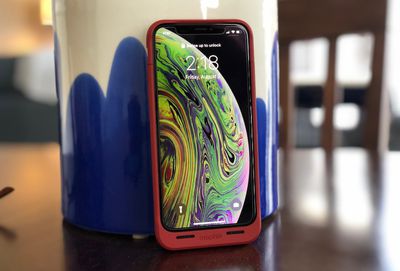
Performance
In regard to daily battery life, I found the Smart Battery Case and Juice Pack Air similar in terms of performance, with an edge given to Apple's case. The Juice Pack Air has a 1,720 mAh battery, while the Smart Battery Case has two 1,369 mAh batteries that allow it to run at a higher voltage to yield a total of 10.1 Wh of energy.
On average, the Juice Pack Air lasted until 4 p.m. during a day of normal use, and one day when I was streaming music from my iPhone to my HomePod for a few hours in the morning, the case died at 1 p.m. that afternoon. Although I found that Mophie's accessory died a bit too early in the day, my iPhone's battery was always able to make it to bedtime so I still never had to worry about finding a charging source at night, which is the entire point of battery cases.
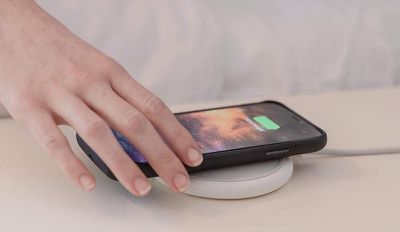
Still, in terms of all-day battery Apple's case routinely beat Mophie's in my testing. The Smart Battery Case usually died around 6 p.m. or 7 p.m. on my normal usage days, and I'd go to bed with my iPhone at around 70-80 percent battery, compared to 30-50 percent battery with the Juice Pack Air.
On the plus side for the Juice Pack Air, it never faced repeated connection issues that are well known with the Smart Battery Case. This problem sees the accessory connect and re-connect to the iPhone randomly when it's being jostled in a pocket or a bag. Likewise, the Smart Battery Case can sometimes cease charging overnight when it's on a Qi mat, so that you'll wake up to only a half-charged case. I never faced any such issues with the Juice Pack Air, although its Qi hotspot was a bit more difficult to find on my Belkin charging mat, especially at night.
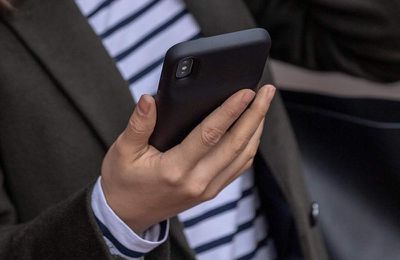
Although Mophie's Juice Pack Air for iPhone XS is not officially certified to fit the iPhone X, it functions as expected. I had no trouble with the case fitting my iPhone X or facing performance issues, so iPhone X owners interested in Mophie's new accessory don't need to worry about this side of things.
Design
The new Juice Pack Air continues Mophie's click-together design, where you slip your iPhone into the bottom portion of the case and snap the top half of the case to the top of your iPhone. This creates a visible seam on the back of the case, just above the enlarged battery portion and below the camera cutout.
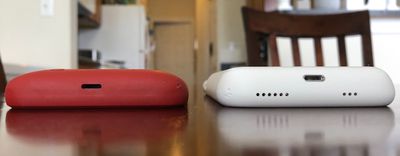
The battery bump on the Juice Pack Air is smaller than Apple's, but the reason for that is because the Mophie case has more length to it -- and thus more surface area to spread out -- due to the large chin on the front of the case. While I liked how thin it felt for a battery case, I didn't like the trade off of having the large chin on the case.
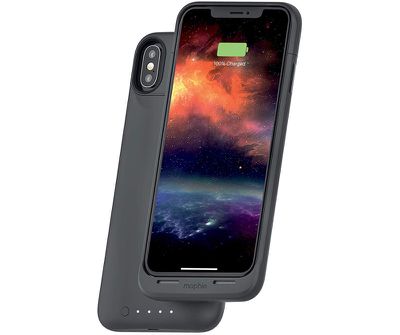
Otherwise, the Juice Pack Air design is standard for an iPhone case, with a passthrough Lightning port, raised front edges, bumpers for the volume and lock buttons, and a satisfying matte finish. The case also performed well when I accidentally dropped my iPhone on concrete one day, with only one small nick near the case's camera bump cutout showing any signs of damage (my iPhone was unscathed).
It's worth noting that this is Mophie's first case that includes charging through a passthrough Lightning port. Previously, Mophie's battery cases included a MicroUSB port for passthrough wired charging. With a Lightning port -- and wireless charging -- keeping the Juice Pack Air topped off is far easier.
Juice Pack Air vs Smart Battery Case
The biggest issue I had switching from Apple's case to Mophie's was the lack of iOS integration with the Juice Pack Air. Apple's Smart Battery Case displays the battery life of the case itself every time you charge it, and in the iOS Widgets screen, making it a cinch to quickly see how much battery you have left in total. It's a small bonus, but one that became so wholly integrated into my day-to-day iPhone X usage that I felt a bit hindered without it.
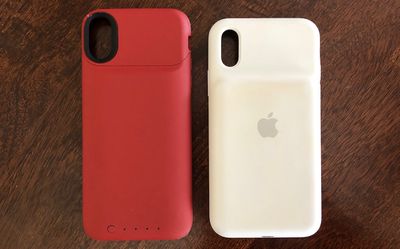
In comparison, the Juice Pack Air has four small LED lights on the lower back of the case. A button to their left can be pressed and the LEDs will activate to represent how much battery is left in the case, and holding it will turn the case on to charge your iPhone.
I had an ongoing issue with guessing what battery was left in the Juice Pack Air, particularly as the LEDs would dwindle down to two or three lights fairly early in the day, and then stay at one light until around 4 or 5 p.m. For those afternoon hours, I never knew exactly how close the case was to being dead.
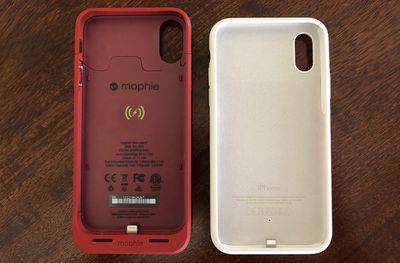
Turning on the two cases is also very different. With Apple's, the case simply activates the minute it's charged and is always providing battery to the iPhone. With Mophie's you have to manually activate it with a long press of the button next to the LEDs.
This is a difference that can either be a pro or con, depending on how much control you want over your battery case. I liked not having to think about turning the case on, but those who would prefer to run out their iPhone battery a little bit before it begins charging would find advantage in the Juice Pack Air.
Bottom Line
Mophie's new line of Juice Pack Air cases for the iPhone XS and XS Max offer the battery life and solid craftsmanship that's expected from Mophie, but a few of its design choices keep it from being the absolute best iPhone battery case on the market.
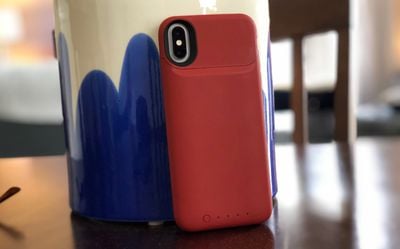
At $99.95, you're essentially doubling the battery life of your iPhone in an accessory that has a sleek body but unattractive chin design. For $30 more at $129.00, Apple's case just nudges out Mophie's in terms of battery life, and has a more subtle design, barring a slightly bigger battery hump.
If you need a battery case for an iPhone X, XS, or XS Max that can barely make it through the day on its own, the Juice Pack Air is still a solid choice in its price range.
How to Buy
The Juice Pack Air for iPhone XS and XS Max is available to purchase for $99.95 on Mophie.com. Colors available include Black, Gold, Navy, and Deep Red.
Note: Mophie provided MacRumors with the Juice Pack Air for iPhone XS for the purposes of this review; no other compensation was received. MacRumors is an affiliate partner with Mophie. When you click a link and make a purchase, we may receive a small payment, which helps us keep the site running.
























Top Rated Comments
Because iOS can communicate directly with Apple's case, it means wear on the internal iPhone battery is reduced as its the iPhone's CPU handling when and where to get power from and how to manage battery power, not the user.
The only thing I do not like is that I have to look at the today widget to see battery percentage of the case, iOS should merge the two batteries and show a combined battery percentage in the status bar, or show both batteries, like dual sim.
I’m imagining wirelessly charging my AirPods on the go.
[doublepost=1566304816][/doublepost]I think everything I buy now has that "May cause cancer" warning.
That "California Proposition 65" warning disclaimer that by law must be on all things plastic.